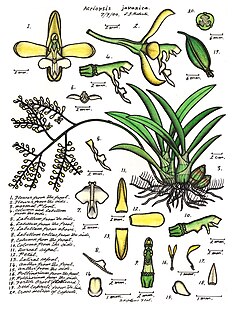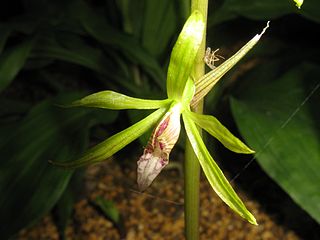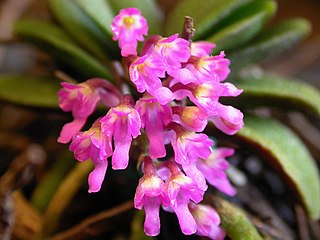
Acriopsis javanica is a species of orchid that is native to Southeast Asia, New Guinea, some Pacific islands and northern Australia. It is a clump-forming epiphyte with dark green leaves and curved, branching flower stems with many white and cream-coloured flowers with purple markings.

Spathoglottis plicata, commonly known as the Philippine ground orchid, or large purple orchid is an evergreen, terrestrial plant with crowded pseudobulbs, three or four large, pleated leaves and up to forty resupinate, pink to purple flowers. It is found from tropical and subtropical Asia to Australia and the western Pacific including Tonga and Samoa.

Nervilia concolor, commonly known as the tall shield orchid and as Nervilia aragoana in Australia is a small terrestrial orchid found in South and Southeast Asia and in northern Australia. It has pale green, short-lived flowers with a cream-coloured or yellowish labellum and a more or less circular leaf which emerges at the base of the flowering stem after flowering.

Taeniophyllum, commonly known as ribbon roots or 带叶兰属 is a genus of about 240 species of epiphytic or lithophytic plants from the orchid family, Orchidaceae. Plants in this genus are more or less leafless with a very short stem and roots that are often flat, green and photosynthetic. The flowers are small, short-lived, flat or tube-shaped and arranged on short, thin flowering stems. Orchids in this genus are found in Africa, tropical and subtropical Asia, New Guinea, Australia and some Western Pacific Islands.

Schoenorchis, commonly known as flea orchids, or 匙唇兰属 , is a genus of flowering plants from the orchid family, Orchidaceae. Plants in this genus are small epiphytes with thin roots, thin leafy stems with leaves in two ranks and tiny fragrant, almost tube-shaped flowers with a prominently spurred labellum. There are about twenty five species found from tropical and subtropical Asia to the Western Pacific.

Plectorrhiza tridentata, commonly known as the common tangle orchid, is an epiphytic or lithophytic orchid that has many coarse, tangled roots, up to twenty egg-shaped leaves and up to fifteen green or brown, star-shaped flowers with a white labellum. It grows on rainforest trees and in other humid places and occurs between the Daintree National Park in Queensland and the far north-eastern corner of Victoria.

Goodyera rubicunda, commonly known as the giant jewel orchid, is a species of orchid that is native to parts of India, Asia, Southeast Asia, New Guinea, Queensland and some Pacific Islands where it grows in damp forest and rainforest. It has between three and six large, egg-shaped leaves and up to ten dull pink and white resupinate flowers that are hairy on the outside.
Dendrobium convexum, commonly known as the piggyback orchid, is an epiphytic orchid in the family Orchidaceae. It has a creeping, brittle root, erect pseudobulbs with a single leaf on the top and one or two cream-coloured, short-lived flowers with a red and yellow labellum. It is native to Southeast Asia, New Guinea and tropical North Queensland, Australia.

Plectorrhiza brevilabris, commonly known as the small tangle orchid, is an epiphytic or lithophytic orchid endemic to Australia. It has many coarse, wiry roots, between three and nine bright green leaves and up to twenty green, star-shaped flowers with reddish brown markings and a white patch on the labellum. It grows in rainforest on trees, shrubs and occasionally on rocks and occurs on the near coastal ranges of eastern Queensland.

Pomatocalpa marsupiale, commonly known as the branched bladder orchid, is an epiphytic or lithophytic orchid that forms large clumps. It has many thick roots, branched stems, many strap-like, leathery leaves and up to many upward-facing green flowers with a cream-coloured or yellowish labellum. It usually grows on high on rainforest trees and is found between Sulawesi and tropical North Queensland, Australia.

Robiquetia gracilistipes, commonly known as the large pouched orchid, is an epiphytic or lithophytic orchid from the family Orchidaceae that forms large, hanging, straggly clumps. It has long, thick, roots, a single stem, many thick, leathery leaves and up to forty cream-coloured, pale green or brownish flowers with red spots and a three-lobed labellum. It grows on trees and rocks in rainforest, usually in bright light. It is found in Malesia including New Guinea, the Solomon Islands and tropical North Queensland, Australia.

Schoenorchis sarcophylla, commonly known as the fleshy flea orchid, is a small epiphytic orchid with many thin roots, between three and seven crowded, dark green leaves and up to thirty crowded, tube-shaped white flowers. It is found in New Guinea and tropical North Queensland.
Thrixspermum platystachys, commonly known as the starry hairseed, is an epiphytic or lithophytic orchid that forms untidy clumps with many tangled, wiry roots, up to ten stiff, leathery leaves and many star-shaped, cream-coloured flowers with an orange and white labellum. This orchid occurs from Papuasia to northern Queensland.

Bryobium queenslandicum, commonly known as the dingy urchin orchid, is an epiphytic or lithophytic clump-forming orchid that has cylindrical, fleshy green pseudobulbs, each with two leaves and between three and twelve small, self-pollinating, cream-coloured or pinkish flowers. This orchid only occurs in tropical North Queensland.
Bryobium retusum, commonly known as the Christmas Island urchin orchid, is an epiphytic clump-forming orchid that has oval, fleshy green pseudobulbs, each with two leaves and between seven and twelve short-lived, self-pollinating, pale green, hairy flowers. This orchid is found between Java and New Caledonia.
Oberonia flavescens, commonly known as the northern green fairy orchid, is a plant in the orchid family and is a clump-forming epiphyte or lithophyte. It has between four and six leaves in a fan-like arrangement on each shoot and a large number of whitish to yellowish flowers arranged in whorls of between six and eight around the flowering stem. It is endemic to Queensland.
Octarrhena pusilla, commonly known as the wispy grub orchid, is an epiphytic or lithophytic plant in the orchid family. It has thin roots, usually only a single stem, between three and six fleshy, cylindrical leaves and up to twenty small, white to cream-coloured flowers. This orchid is endemic to tropical North Queensland.
Thelasis capitata, commonly known as the conical fly orchid, is a plant in the orchid family. It is a clump-forming epiphyte with flattened pseudobulbs, each with a single strap-shaped leaf. A large number of small yellowish green flowers are arranged in a cone shape on a thin but stiff flowering stem. This orchid is found from Thailand to Malesia, including on Christmas Island.

Thelasis carinata, commonly known as the triangular fly orchid, is a plant in the orchid family. It is a clump-forming epiphyte or lithophyte that lacks pseudobulbs. There are groups of between two and six erect, flattened stems each with up to six leaves that have a ridged lower surface. Up to fifteen green and white flowers are arranged on a thin but stiff flowering stem. This orchid is found from Thailand to the southwest Pacific.
Phreatia micrantha, commonly known as the native fan orchid, is a plant in the orchid family and is an epiphyte or lithophyte with four to ten channelled leaves in a fan-like arrangement with their bases sheathing the stem. A large number of small white, cup-shaped flowers are arranged along a thin, wiry flowering stem. This orchid is native to areas between Papuasia and the western Pacific.













